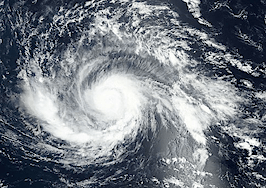Broker-associate Elliot Machado watched his normally bustling Miami urban neighborhood of Brickell transform into a violent underwater ghost town this weekend — from a distance. Amid grisly Irma forecasts and an evacuation order, Machado went north — way north — to hurricane-free Minnesota, and took in the storm via live stream.
“I’ve never seen it like that, ever, and I’ve been there for 12 years,” said Machado, a One Sotheby’s International Realty agent who specializes in Brickell, the financial district home to prized real estate including 100 apartment buildings and a number of banks and high-profile company offices.

Elliot Machado
Although Miami didn’t bear the wrath of Irma’s eye, powerful winds nevertheless dumped heaps of floodwaters into Florida’s coastal areas. Surging waves at Brickell Ave. and Coral Way in Miami poured into residential and commercial structures just two blocks from One SIR’s office on 10th (which is fortunately on the fifth floor).
The flooding in that area had cleared up by 10 this morning, receding to the bay.
Machado isn’t sure how his own home, five minutes from Brickell, fared the hurricane, and he hasn’t received word about any clients or colleagues being in harm’s way. One friend in the area, however, reportedly did not appreciate the hurricane’s sway effect from her 34th floor condo perch, dry as it was.
“Up that high, you experience 17 percent higher winds,” Machado said. “She said it was very scary but she did feel safe because the windows held up but the howling and whistling winds were pretty eerie.” Adding to the mix were construction cranes swaying around buildings like a terrifying amusement park ride during the height of Irma’s visit.
Machado predicts his current deals — he currently has six under contract — will only be somewhat delayed as appraisers ensure the properties are still intact. But fallen trees and power lines could complicate cleanup.

Christopher Zoller
On that note Christopher Zoller, chairman of the Miami Association of Realtors’ board of directors, had some positive news to share: Miami’s underwater ecosystem mitigated damages this weekend.
“Miami-Dade county is built on top of what amounts to a coral reef, a porous rock foundation, which is why our rain water is draining faster than Houston,” Zoller said. “It is solid but porus rock; the rain comes in and there is a momentary flooding situation, but in a matter of hours as opposed to a week, the water drains away thanks to this Biscayne Aquifer.”
Under Florida’s “force majeure” provisions, sellers are required to make any repairs that happened “by an act of God.” That will delay closings while any repairs are done and inspections come out, but Zoller anticipates that real estate deals will resume quickly.
“I was personally involved in real estate deals when Andrew hit us, and the same thing happened, I was under contract with three deals,” Zoller said. “We’ve all been here before, this is nothing new. We are fortunate to have some very good cooperative insurance companies who understand the system here. There is a synergy of work between title, escrow, attorneys and the Realtors for buyers and sellers.”
Zoller and his fellow leaders at the Miami Association of Realtors are still collecting in damage reports from across the entire region. Trees took the biggest hit, he said, so the the priority is to keep roadways open. Irma battered Naples, Fort Myers and the Florida Keys the hardest.
The National Association of Realtors and Florida Association of Realtors both have relief funds to aid in getting people back on their feet. Zoller encouraged anyone needing help to use them as a resource.

“Miami is the largest association in the country,” Zoller said. “We are prepared to help our own members and the state of Florida and in Texas, too.”
Christina Pappas, residential president of the Miami Association of Realtors, gave a message of hope to her region’s Realtors: “It’s going to be dark for one or two months but typically we see a boom in real estate shortly after a big hit like this.
“After Andrew and Katrina, Realtors saw their best year ever.”







